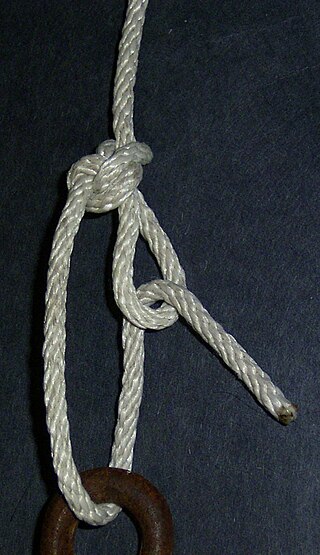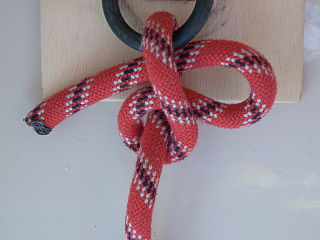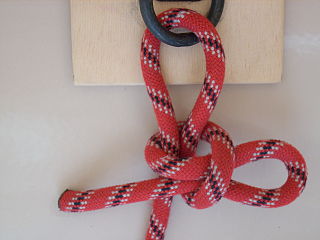
A knot is an intentional complication in cordage which may be practical or decorative, or both. Practical knots are classified by function, including hitches, bends, loop knots, and splices: a hitch fastens a rope to another object; a bend fastens two ends of a rope to each another; a loop knot is any knot creating a loop; and splice denotes any multi-strand knot, including bends and loops. A knot may also refer, in the strictest sense, to a stopper or knob at the end of a rope to keep that end from slipping through a grommet or eye. Knots have excited interest since ancient times for their practical uses, as well as their topological intricacy, studied in the area of mathematics known as knot theory.

The bowline is an ancient and simple knot used to form a fixed loop at the end of a rope. It has the virtues of being both easy to tie and untie; most notably, it is easy to untie after being subjected to a load. The bowline is sometimes referred to as king of the knots because of its importance. Along with the sheet bend and the clove hitch, the bowline is often considered one of the most essential knots.

The overhand knot is one of the most fundamental knots, and it forms the basis of many others, including the simple noose, overhand loop, angler's loop, reef knot, fisherman's knot, half hitch, and water knot. The overhand knot is a stopper, especially when used alone, and hence it is very secure, to the point of jamming badly. It should be used if the knot is intended to be permanent. It is often used to prevent the end of a rope from unraveling. An overhand knot becomes a trefoil knot, a true knot in the mathematical sense, by joining the ends. It can also be adjusted, faired, or mis-tied as a half hitch.

A miller's knot is a binding knot used to secure the opening of a sack or bag. Historically, large sacks often contained grains; thus the association of these knots with the miller's trade. Several knots are known interchangeably by these three names.

The constrictor knot is one of the most effective binding knots. Simple and secure, it is a harsh knot that can be difficult or impossible to untie once tightened. It is made similarly to a clove hitch but with one end passed under the other, forming an overhand knot under a riding turn. The double constrictor knot is an even more robust variation that features two riding turns.

The clove hitch is an ancient type of knot, made of two successive single hitches tied around an object. It is most effectively used to secure a middle section of rope to an object it crosses over, such as a line on a fencepost. It can also be used as an ordinary hitch, or as a binding knot, but it is not particularly secure in either application. It is considered one of the most important knots, alongside the bowline and the sheet bend.
Although the name clove hitch is given by Falconer in his Dictionary of 1769, the knot is much older, having been tied in ratlines at least as early as the first quarter of the sixteenth century. This is shown in early sculpture and paintings. A round turn is taken with the ratline and then a hitch is added below. The forward end is always the first to be made fast.

The trucker's hitch is a compound knot commonly used for securing loads on trucks or trailers. The general arrangement, using loops and turns in the rope itself to form a crude block and tackle, has long been used to tension lines and is known by multiple names. Knot author Geoffrey Budworth claims the knot can be traced back to the days when carters and hawkers used horse-drawn conveyances to move their wares from place to place.

The marlinespike hitch is a temporary knot used to attach a rod to a rope in order to form a handle. This allows more tension than could be produced comfortably by gripping the rope with the hands alone. It is useful when tightening knots and for other purposes in ropework.

The taut-line hitch is an adjustable loop knot for use on lines under tension. It is useful when the length of a line will need to be periodically adjusted in order to maintain tension. It is made by tying a rolling hitch around the standing part after passing around an anchor object. Tension is maintained by sliding the hitch to adjust the size of the loop, thus changing the effective length of the standing part without retying the knot.

A slipped half hitch is a knot in which the weight of the load the rope carries depresses the loop sufficiently to keep it in place until the load item is placed in its location. When no longer required the free end may be pulled and draw the loop through and so release the load.

The Cat's paw is a knot used for connecting a rope to an object. It is very similar to the cow hitch except there is an additional twist on each side of the bight, making it less prone to slipping.
The cat's-paw is the common hook hitch for slings. It is the same basic form as the bale sling hitch but has additional twists. Brady says "two or three altogether," and Steel, who mentioned the name in 1794, says "three twists." It is the best of all sling hitches and is often recommended for a slippery rope. But no hitch can slip when tied in a slings since it has no ends. All that is needed is a hitch that cannot jam, and this requirement the cat's-paw fills admirably. The knot spills instantly when removed from the hook. It is the hitch always used for heavy lifts.

The buntline hitch is a knot used for attaching a rope to an object. It is formed by passing the working end around an object, then making a clove hitch around the rope's standing part and taking care that the turns of the clove hitch progress towards the object rather than away from it. Secure and easily tied, the buntline hitch will jam when subjected to extreme loads. Given the knot's propensity to jam, it is often made in slipped form.
The buntline hitch, when bent to a yard, makes a more secure knot than two half hitches, but is more liable to jam. It differs from two half hitches in that the second half hitch is inside instead of outside the first one.

The halter hitch is a type of knot used to connect a rope to an object. As the name implies, an animal's lead rope, attached to its halter, may be tied to a post or hitching rail with this knot. The benefit of the halter hitch is that it can be easily released by pulling on one end of the rope, even if it is under tension. Some sources show the knot being finished with the free end running through the slipped loop to prevent it from working loose or being untied by a clever animal, still allowing easy but not instant untying.

The double overhand knot or barrel knot is simply an extension of the regular overhand knot, made with one additional pass. The result is slightly larger and more difficult to untie. It forms the first part of the surgeon's knot and both sides of a double fisherman's knot. According to The Ashley Book of Knots, "A double overhand knot tied in a cat-o'-nine-tails is termed a blood knot."

The strangle knot is a simple binding knot. Similar to the constrictor knot, it also features an overhand knot under a riding turn. A visible difference is that the ends emerge at the outside edges, rather than between the turns as for a constrictor. This knot is a rearranged double overhand knot and makes up each half of the double fisherman's knot.
The strangle knot starts with a round turn and the end is stuck under two parts. It may be used to tie up a roll. It can only be tied around a cylindrical shape. If required, a loop may be stuck instead of the end, which makes a slipped knot that is one of the best for tying up sacks and meal bags. With one or two additional turns the strangle knot makes an excellent temporary whipping for the end of a rope.

In knot tying, a bight is a curved section or slack part between the two ends of a rope, string, or yarn. A knot that can be tied using only the bight of a rope, without access to the ends, is described as in the bight. The term "bight" is also used in a more specific way when describing Turk's head knots, indicating how many repetitions of braiding are made in the circuit of a given knot.

The highpoint hitch is a type of knot used to attach a rope to an object. The main feature of the hitch is that it is very secure, yet if tied as a slipped knot it can be released quickly and easily with one pull, even after heavy loading. The highpoint hitch is tied in the same manner as a slipped buntline hitch until the final turn, where they diverge.

A pipe hitch is a hitch-type knot used to secure smooth cylindrical objects, such as pipes, poles, beams, or spars. According to The Ashley Book of Knots, a pipe hitch is "used to lower a pipe or hoist one" and as "another method of tying to a rectangular timber."





















